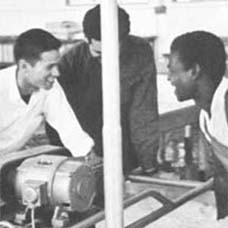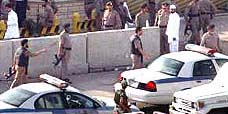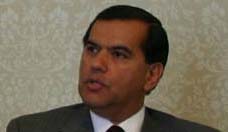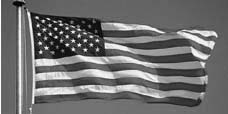
The publication of Suburbia, which sold a staggering 50,000 copies in three editions, justly transformed the small town local newspaper photographer Bill Owens (RPCV Jamaica) into a star
Bill Owens
From the July/August 2000 issue of the British magazine: "The Royal Photographic Society Journal"
by Simon James
American photographer Bill Owens is the author of Suburbia, one of the classic photography books of the last century. Born in 1938, at the latter end of the American Depression, his father was a mule skinner and sometime coal miner who moved to California to find construction work and his mother was a nurse's aid, who in the war years worked in an aircraft factory. A mule skinner incidentally, wasn't somebody who skinned mules for their leather; the term describes a subsistence farmer who scraped a very meagre living by force of will and the extraction of every last ounce of a single mule's effort. They were a close family that had weathered the hard times by the sweat of their labour and Owens remembers how they grew their own produce and raised small amounts of livestock to make ends meet. Owens himself was something of a late developer, barely getting good enough grades to pass into his local college, who admits he didn't read a book from beginning to end before the age of twenty-one. He first became interested in photography while working as a Peace Corps volunteer in Jamaica and on his return to the USA in 1966 he took a course in visual anthropology in San Francisco. Considering his background it comes as little surprise to discover he was moved by the work of the nineteen thirties documentary photographers. He spent much of his free time devouring photography magazines and says "I really liked the work of Margaret Bourke-White and others but the pictures that spoke most to me were the Farm Security Administration images of Dorothea Lang. She seemed to transcend the dust bowl and really capture the soul of America."
The course, and his late found determination, paid off. In 1967 he landed a job as the staff photographer on the Livermore Independent local newspaper. By now he was twenty-nine years old and, by the standards of some of his compatriots, well travelled. To some, even in today's America, international travel is of no particular virtue and might even be considered odd; but Owens acquired a benefit that only extended travel can offer. He experienced enough difference to take a more detached look at the familiar. On his new journeys, as a professional witness through the lives of the town, he noticed the way in which those who'd stayed at home had begun to achieve a very comfortable life style. It was by no means uncommon for friends from similarly humble backgrounds to his own to be living in, and paying the mortgages on, new houses with two car garages and in some cases even swimming pools. The American Dream seemed to have moved from the realms of myth into reality and Owens determined to record this transformation for posterity.
From Monday to Friday he worked on 35mm, recording the happenings of the town for the newspaper. The post-war boom was changing the fabric of America and his travels around Livemore rekindled his interest in the American soul. Owens began to see the town as a living thing and applied to the Livermore council for a grant to produce documentary photographs for the town archives. He continues "I made the first photographs for the Suburbia series in 1967 while I was full time on the Livemore Independent. Working on the paper put me in a prime position to see the images but I couldn't shoot for the paper and then claim the images for myself. Pictures made for the paper remained their property, so I would shoot my personal work on Saturdays using a Pentax 6x7 and a Brooks Veriwide 6x9. Some of the subjects were people I had photographed previously for the Independent, others were my relatives and friends who lived nearby, and some came to me in response to advertisements I placed locally, looking for people who would be prepared to let me photograph them and their homes."
"Originally the photographs stood alone but when I found the publisher and mentioned the people had stories to tell they suggested I should include captions with the pictures. I was then told we would need model releases for all the subjects. This of course was no problem because I knew them all, and many of the captions were obtained at the same time as the model releases. The original quotes, such as "How can I worry about the damned dishes when there are children dying in Vietnam?", are often written on the backs of the release forms. Sometimes I'd show them the picture and the quote would come right out, while on other occasions we would sit down and work at it until we had something they felt happy with. I was after all producing a documentary and keen to have the subjects speak for themselves rather than try and stamp too much of my own personality or opinions on the photographs." The images should not, however, be thought of as random. Owens was aware from the outset of the size of the task he had set himself and assembled a very careful shooting script before starting work on the project. Events to be covered included nationally recognised festivals: Christmas, Thanksgiving and the Fourth of July along with more local or personal happenings such as family birthdays, barbecues and parties. He also believes very firmly in the integrity of the image and to this day refuses to garden or over art-direct a shot, as he feels that such interference injects a phoney quality to final result.
The USA is often misdescribed as a classless society but Owens, the insider, clearly and categorically states that the subject of his interest was the middle class. The estate in the Livermore Valley was the USA in microcosm. It's inhabitants had indeed never had it so good and were keen to enjoy, and to some extent show off their new found wealth; but Owens' depiction of his contemporaries is far from fawning. On occasion it exhibits an almost surgical precision in its dissection of the minutiae of the late sixties American soul. Sheer Americanness is also an important key to his own makeup. Owens' motivation is to document rather than to criticise: he is the witness who observes from within. He believes deeply in the traditional American values: the American Dream of achieving prosperity in return for hard work and the all important duty to provide your children with a better start in life than you were given yourself.
The publication of Suburbia, which sold a staggering 50,000 copies in three editions, justly transformed the small town local newspaper photographer into a star. He went on to produce two more books, Our Kind of People and Work: I Do It For The Money, but failed to achieve the financial stability that his ambitions demanded. In the mid seventies, after failing to find a publisher for a fourth book looking at Americans at leisure, he made the decision to find another way of earning a living. Hanging up his cameras "for good" he sold his 35mm equipment to finance a research trip to England and for the past few years has made his living as proprietor and chief brewer of Buffalo Bill's microbrewery in Hayward, ten miles away from the Livermore estate. He later founded and continues to publish American Brewer magazine. Recently however, thanks to the intervention of his friend and now agent, Robert Shimshak, he has searched out, reprinted and updated the Suburbia series for a fourth, and equally well received edition of the book. Having effectively abandoned photography for fifteen years Owens has been thrown once more into the limelight. On his home turf he finds himself re-visiting some of the original sitters from Suburbia for such prestigious publications as the New York Times. Richie, the child on the tricycle whose mother's statement discussed her decision to allow him to play with a toy gun, in adulthood living about a mile from where he was brought up, turns out to be happily married, have a young baby and ride a Harley Davidson. Divorce seems to have affected the residents of the Livermore estate, and Owens himself, about as much as it has the rest of the USA. Ken, for example, who in Suburbia proudly showed off his mirror lined bedroom, now lives with Althea whose concern in the original book was that American Express not discover her actual circumstances. Sex incidentally turns out to have been a late entrant to the original series, injected only when the publishers announced that a book about contemporary American living and values couldn't leave it out. About a quarter of those who appear in Suburbia still live in the same houses on the estate, although Bill has moved on from Yosemite Drive. He currently he has a one man show at Artandphotographs, London's newest photography gallery, recently gave a presentation at the ICA, and the leisure book, whose failure to find a publisher originally persuaded him to look for a new source of income, will finally see the light of day in 2001. On his recent visit to London he was happily clutching a brand new Mamiya 7 and two lenses, whose leaf shutter he delightedly explained to me allows him to make the sort of fill flash pictures he can't produce with his Pentax 6x7. Owens himself is now heavily into the planning stage of a new, long term, documentary project on the subject of the good life. Buffalo Bill it would appear, is back in the saddle, loaded up with 220, and heading out.
(c) Simon James 22/5/00
Bill Owens - Images from Suburbia runs at artandphotographs, 13 Mason's Yard, St James's, London SW1Y 6BU Telephone 020-7321-0495 until June 30 2000, Tuesdays to Fridays 11.00 - 6.00 www.artandphotographs.com
Suburbia, Bill Owens (revised and updated edition) Hard back £24.95 Published by Fotofolio, New York
ISBN 1-881270-40-8
Distributed in the UK by Art Data
Telephone 020-8747-1061










